
Pensacola is the westernmost city in the Florida Panhandle, and the county seat and only incorporated city of Escambia County, Florida. Pensacola is the principal city of the Pensacola Metropolitan Area, which had an estimated 502,629 residents in 2019. At the 2020 United States census, the population was 54,312.

Pensacola Beach is an unincorporated community located on Santa Rosa Island, a barrier island, in Escambia County, Florida, United States. It is situated south of Pensacola in the Gulf of Mexico. As of the 2000 census, the community had a total population of 2,738. It has been described as "famous" for its ultra-white sand beaches.
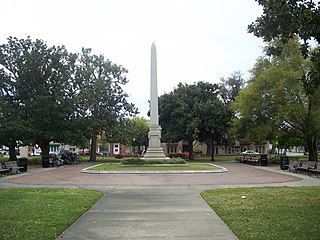
The Plaza Ferdinand VII is an outdoor garden and park in the Historic Pensacola Village area of downtown Pensacola, Florida. It is located on Palafox Street between Government and Zaragoza Streets. It was named after Ferdinand VII of Spain, the King of Spain between 1813 and 1833. A National Historic Landmark, it is the site of the formal transfer of Florida to United States jurisdiction in 1821.

The Pensacola metropolitan area is the metropolitan area centered on Pensacola, Florida. It is also known as the Pensacola-Ferry Pass-Brent Metropolitan Statistical Area, a metropolitan statistical area (MSA) used for statistical purposes by the United States Census Bureau and other agencies. The Pensacola Standard Metropolitan Statistical Area was first defined in 1958, with Pensacola as the principal city, and included Escambia and Santa Rosa counties. The SMA was renamed Pensacola-Ferry Pass-Brent MSA in 2003, with the unincorporated census-designated places Ferry Pass and Brent added as principal cities. The population of the MSA in the 2020 census was 511,502.

The North Hill Preservation District is a U.S. historic district located in Pensacola, Florida. The district is bounded by Blount, Palafox, Wright, Belmont, Reus, and DeVilliers Streets. It contains 425 historic buildings and 1 object.
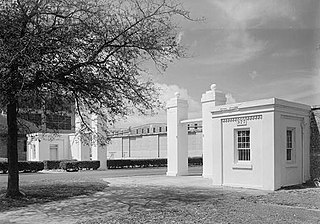
The Pensacola Naval Air Station Historic District encompasses the early historic elements of Naval Air Station Pensacola in Warrington, Florida. Included in the historic district are surviving buildings of the Pensacola Navy Yard, which the air station took over, as well as buildings related to the early years of aviator training by the United States Navy. The district, roughly bounded by West Street, Saufley Avenue, and Pensacola Bay, was designated a U.S. National Historic Landmark District in 1976.

Fort George was a British fort built in 1778 for the protection of Pensacola, Florida. The Spanish captured it in Siege of Pensacola on May 10, 1781.

The Pensacola Hospital was a hospital in Pensacola, Florida, United States, located at 1010 North 12th Avenue. On February 16, 1982, it was added to the United States National Register of Historic Places.

The Saenger Theatre, also known as the Saenger Theater, is a historic theater in Pensacola, Florida. It is located at 118 South Palafox Place. On July 19, 1976, it was added to the U.S. National Register of Historic Places.
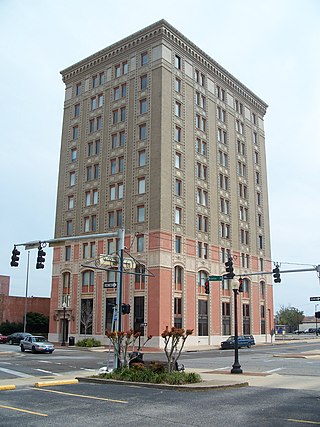
The American National Bank Building is a historic bank in Pensacola, Florida, United States. On November 17, 1978, it was added to the U.S. National Register of Historic Places. It was designed by New York architect J. E. R. Carpenter.

The Thiesen Building, built in 1901, is a historic site in Pensacola, Florida. It is located at 40 South Palafox Street. On December 13, 1979, it was added to the U.S. National Register of Historic Places.
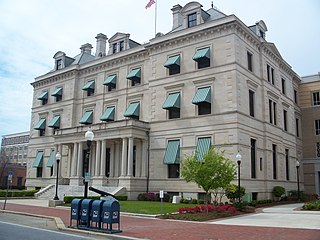
The U.S. Customs House and Post Office, also known as the Escambia County Courthouse, is a historic site in Pensacola, Florida. Built in 1887, it is located at 223 Palafox Place. On July 22, 1997, it was added to the U.S. National Register of Historic Places.
The history of Pensacola, Florida, begins long before the Spanish claimed founding of the modern city in 1698. The area around present-day Pensacola was inhabited by Native American peoples thousands of years before the historical era.
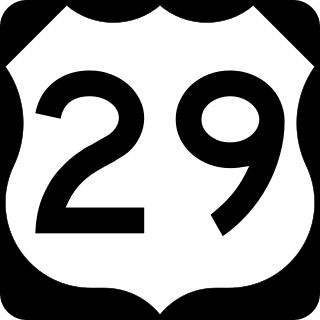
U.S. Highway 29 (US 29) in the state of Florida is the westernmost north–south United States Numbered Highway in the state. It runs 43.6 miles (70.2 km) from downtown Pensacola north to the Alabama state line entirely within Escambia County. US 29 runs as a four-lane highway through much of the Florida Panhandle, becoming six lanes through and near several towns. The highway's hidden state road designation is entirely State Road 95 (SR 95).
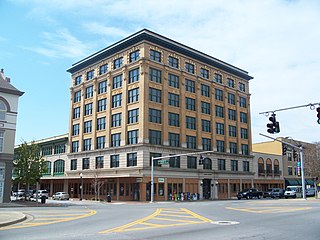
The Blount Building is an historic seven-story Chicago school style office building located at 3 West Garden St., SW corner of Palafox St., Pensacola, Escambia County, Florida. It was built by Charles Hill Turner in 1906-1907 for local attorney William Alexander Blount on the site of the three-story Blount-Watson Building, which had burned on Halloween night in 1905. The building features so-called Chicago windows and contains in its exterior the contain the three parts of a classical column, with the first and second floors being the base of the column, the third through sixth floors the shaft and the seventh floor the capital. The first floor exterior has been changed over the years reflect different retail needs, but the exterior of the upper floors remains intact.
Mowbray & Uffinger comprised an architectural partnership in New York City formed in 1895. Known for bank buildings and as vault engineers they designed over 400 banks in the pre-World War II era throughout the country. The principals were Louis Montayne Mowbray (1867-1921) and Justin Maximo Uffinger Sr. (1871-1948).
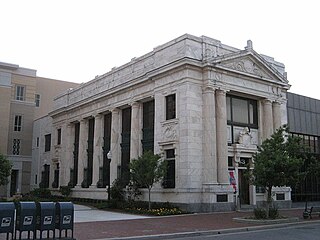
Palafox Place is a major commercial area in downtown Pensacola, Florida, United States. It comprises three blocks of South Palafox Street, south of Garden Street and north of Government Street, which was formerly the main downtown shopping district.

The Winston E. Arnow Federal Building is a national historic site located at 100 N. Palafox St., Pensacola, Florida in Escambia County. Originally built as a courthouse and post office, the building was constructed in 1938 and 1939 and is an example of the Simplified Classical style frequently used for federal buildings in late 1930s and early 1940s. In 2004 it was named for district judge Winston E. Arnow.

Evelyn Tucker was one of a handful of women who were employed as "Monuments Men" after World War II. According to Bryce McWhinnie, a researcher with the Monuments Men Foundation, several "unsung female American MFA&A officers"—Rose Valland, Capt. Edith A. Standen, Evelyn Tucker, and Capt. Mary J. Regan, "put their personal interests in jeopardy in order to protect priceless art." All under the age of 40 when they entered their respective service positions, "each of these women left her own mark on postwar cultural heritage restitution policy."

The Palafox Historic District comprises 129 properties in Pensacola, Florida. The district includes 100 contributing buildings, 28 non-contributing buildings, and 1 non-contributing site. The National Register district, listed under the category Commerce/Trade, runs along Palafox Street and is bounded roughly on the north by Chase Street, on the south by Main Street, and extends to Spring Street on the west. The Palafox Historic District joins 38 other National Register of Historic Places listings in Escambia County, Florida.



















